Archives When you Hear the News Back Home
“When You Hear the News Back Home…”
The Career of Brigadier General William A. Bloomer
(U.S.M.C., Ret.)
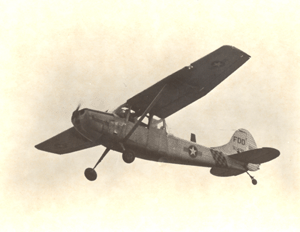
USS Midway, 30 April 1975
Dearest Susie & kids,
Yesterday and today have been two of the most indescribable days of my life. The monotony of waiting for something to happen was shaken to levels one can't even begin to imagine. When you hear the news back home, people I'm sure won't ever give it a second thought as that is the natural reaction for something that is far away and carries no meaning for you. But when you are witness first hand to evacuees fleeing for their lives in the proportion that I have seen these past two days, it is something that affects you deeply.
At about 6:30 a.m. yesterday it started to happen. A Vietnamese Army pilot had flown a CH-47 Chinook helo to the USS Blue Ridge with his family....
In April 1975, Lieutenant Colonel William A. "Art" Bloomer was commander of the Marine Composite Reconnaissance Squadron-1 assigned to the USS Midway off the coast of Vietnam. Over a two-day period during Operation Frequent Wind, the evacuation of Saigon, the USS Midway received over 2,000 refugees. In a letter home (links to 10.4.3.2.6) to his wife and children, Colonel Bloomer described the drama of "evacuees fleeing for their lives."
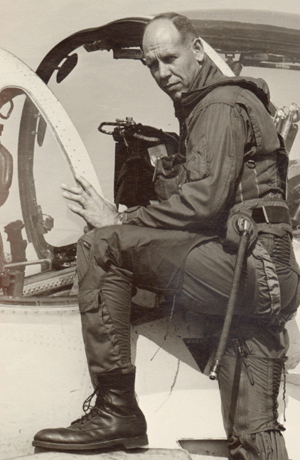
Marine Pilot, Aide-de-Camp, Commander, Corporate Executive
Emporia State Class of 1955 / Distinguished Alumnus, 1985
I was born and raised on a farm.... My earliest memories go back to about 1940, when I was seven or so. I remember my first day of school in Mt. Carmel school [near Bellaire, Kansas]. It was a mile away. We had to walk a mile every day and back. The mailbox was a mile away, too. It was in the opposite direction, it wasn't over by where the school was. A one-room school, all eight grades in the same school, but I don't.... You know, we were very poor when I was growing up, but I didn't know it. I knew it was a real treat to get a nickel to buy an ice cream cone when you could, but an ice cream cone - a big one for a nickel, a double dipper was 10 cents....
From taped interview, November 7, 2003
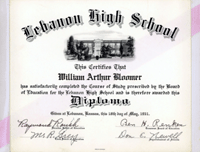
Early Years - Bellaire and Lebanon, Kansas
My Dad never had more than a fourth-grade education. My mother had eight grades of education. And of course [farmers] didn’t really care a whole lot for higher education in the late 1940s, 50s, and didn’t care an awful lot about being in the service. World War II was just over with, so staying out of the service was kind of a primary thing. But I wanted to go to high school. I don’t know why. I always had that burning desire. I learned to read at a fairly early age. I read the papers and I read books. My Grandpa had a lot of books in his house that I read.... I was bigger than most kids. I was a six-footer when I was a freshman in high school. I thought I was awkward and clumsy. Nobody had ever taught me how to play football or basketball or anything like that, and finally when those coaches got a hold of me at Lebanon High School.... One of the first things the basketball coach did, he got me a basketball and helped me put a goal up out there on the farm. I used to practice shooting in the wind and stuff like that, you know, and I learned how to dribble. I couldn’t dribble a basketball when I was a freshman.
From taped interview, November 7, 2003
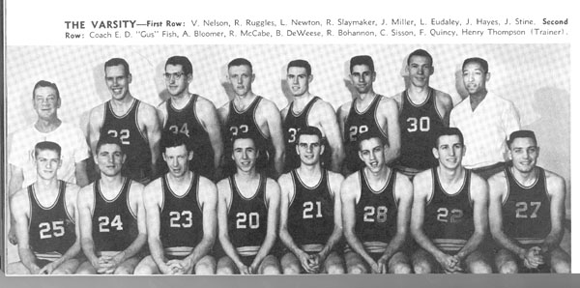
Kansas State Teachers College (now Emporia State University), 1951-1955
He was the last athlete at Emporia State to letter all four years in both basketball and football.
I was working I think on a construction company around Lebanon [Kansas, in the summer of 1951], building roads, and all of a sudden one day I got a phone call from a fellow named Shorty Long. Shorty [had been] a football player here at Emporia State, and at that time he was a football coach, assistant football coach to Fran Welch. He was up in Lebanon and wanted to know if he could come see me and have a cup of coffee or buy me a drink or whatever, buy me a soda. So I stopped at the little old drug store, the only one we had in town, and saw Shorty, and we had a hamburger and drank a Coke. And he said, I want you to come down to see Emporia....
So we came down. I met Fran Welch, and some of the other people that were in school here. A fellow by the name of Bob Scherrer I remember particularly. I met Keith Caywood and Gus Fish. And they told me that they don't have scholarships here at Emporia State, but we can help you out. We can get you a college education.... They told me that it's not a scholarship, we don't have scholarships here, but we can give you a place to stay -- and that place to stay was underneath the football stadium....
That was my desire, to be a teacher and a coach, you know, start coaching high school and then hopefully work my way up to maybe a college. That's what I wanted to do. Fran Welch was a legend in Emporia, and he was my head football coach for the four years. It was his last year as head coach when I was a senior, and of course Gus Fish was about the same as far as basketball was concerned, before Ron Slaymaker came along and coached longer than Gus did. But Gus had been around a long time, and then Keith Caywood was another guy that had been around an awful long time. Pretty good people that I had some early associations with....
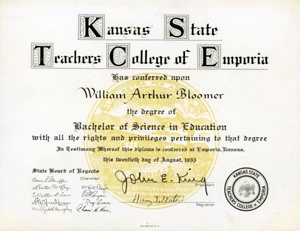
But in 1953 the Korean War was just about to come to an end, and the draft was on in those years.... Actually, I joined the National Guard when I was a freshman thinking that it would get me reclassified and keep me from being drafted. But I joined about six months too late, as I found out in 1953, when I got my notice that said you're drafted.... So I showed that to Gus and he said, oh God, we can't let that happen. There's only one way that you can stay in college these next few years, he said. There's a Marine Corps reserve program called the PLC program, the Platoon Leader Candidate school.... So I joined the Marine Corps Reserves to keep from being drafted. I always tell people I was a draft dodger in the Korean War. I dodged the draft by joining the Marine Corps.
From taped interview, November 7, 2003
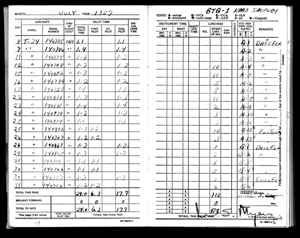
Early Years in the Marines
My wife was delighted, because we were now in Orange County [California, 1956].... It was only like a 25-minute drive away from her grandparents' house. So I'm a motor transport officer at this helicopter base. This is the first time I've ever been around airplanes, and of course I’m making friends with lieutenants that have their wings and they're flying helicopters, and they had a fixed-wing airplane that was called the OE2. It was an artillery spotting plane. I scrounged a couple rides. By that time I'm pretty interested in it. They're making 120 dollars a month more than I am, because they're flying and getting hazardous duty pay. So I said, well, I'm going to find out if I can qualify and take a flight aptitude test. So I did that. I did very well on it, and so I put in for flight training. I didn’t tell my wife.
From taped interview, November 7, 2003
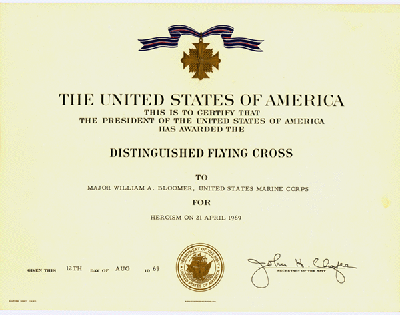
Vietnam - Distinguished Flying Cross, August 1969
"For heroism and extraordinary achievement in aerial flight while serving as a Pilot with Marine Composite Reconnaissance Squadron One, Marine Aircraft Group Eleven, First Marine Aircraft Wing in connection with combat operations against the enemy in the Republic of Vietnam. On 21 April 1969, Major Bloomer launched as Aircraft Commander of an EA-6 Intruder assigned the mission of providing electronic countermeasures support for a United States Navy reconnaissance overflight of a heavily defended section of Vietnam. Arriving over the designated area, he established a flight pattern which would afford the reconnaissance aircraft the most protection, even though this pattern brought his Intruder well within the enemy's antiaircraft missile and artillery envelope. Completely disregarding his own safety, and concerned only with the success of this vital mission, he skillfully maintained an optimum protection flight path for a forty-minute period, thereby enabling his electronic countermeasures operator to effectively jam the hostile target acquisition radar and the reconnaissance flight to complete its mission...."
The Distinguished Flying Cross? I got that flying an EA-6A over -- actually it was one of the jamming missions east of Vinh, in North Vietnam. It was a fairly important mission that had combined strikes of Air Force and Navy planes -- Navy planes coming off the ships, and the Air Force coming out of Thailand. [They were] trying to knock out this huge SAM site that had been shooting down a lot of our airplanes. I and the radar ... our ECM operator, were in a very good airplane that day. Everything was working right in it.... We did press it in, maybe a little further then we were supposed to a couple of times, but we did it because it was pretty critical to those guys that were down there low, and trying to deliver bombs on the target. And, uh, they got out of that mission and never lost an airplane, and that was the first time that anyone had ever flown around Vinh and never lost an airplane.... Now as far as being a dangerous mission, to me it wasn’t any more dangerous then a lot of others that I flew up there, in fact I flew some in the RF-4 that I would classify much more hazardous, with more fire directed at my airplane. I don’t know that we were even shot at on that mission, but we were locked onto with their SAM missile radar, and we were jamming it as hard as we could, and, uh, the fighter planes got in and out, and did their mission. So that’s how I got that one.
From taped interview, November 7, 2003
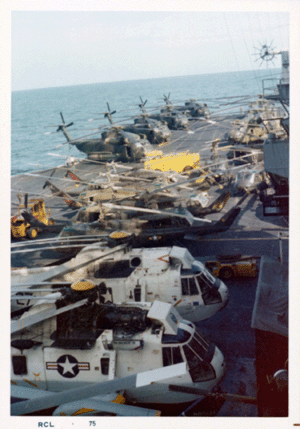
Operation Frequent Wind - The Evacuation of Saigon, April 1975
Dearest Susie & kids,
Yesterday and today have been two of the most indescribable days of my life....
Click here for the text of Lieutenant Colonel Bloomer's letter home.
In April 1975, Lieutenant Colonel Bloomer was commander of the Marine Composite Reconnaissance Squadron-1 assigned to the USS Midway off the coast of Vietnam. Over a two-day period during the evacuation of Saigon, the USS Midway received over 2,000 refugees.
We wound up with 2,000 Vietnamese on our ship that night, and there was no place for them to sleep. I mean, they were sleeping underneath airplanes that we had on the hanger deck.... It was absolutely a mess. The sanitation facilities soon became clogged up and overrun. We didn’t have enough water on the ship, freshwater, to supply all the needs for everybody. It was indescribable what the ship conditions were like there for a little while. Men, women and children, and, uh, it was pitiful to see them.
Now, that was the first day, that was just the ones that the Air Force helicopters brought back. It was the next day, after the first evacuation took place, that the Vietnamese themselves started flying anything they could get to get out of the country. Some of them flew airplanes over into Thailand, the jets that they could get into. The helicopters guys would bring their families, they'd get their families and put them on their helicopter and then they’d fly this helicopter out. At one time we had about 19 helicopters -- they were HUEYs, the smaller ones -- come in and land on the carrier. There was only one operating radio on that flight of 19, and it was a mess. I don’t know how we didn’t have a collision. I don’t know how we didn’t have a rotor hit someone in the head on the deck and kill them, but we didn’t. We only had to push about two or three helicopters over the side to make room for others to come in.
From taped interview, November 7, 2003
The story of the O-1 Birddog began on May 1.... This small two-place airplane used as an artillery spotting plane began flying over the Midway in circles. There was no radio contact with the pilot until we were able to crank up the radio is one of the Vietnamese helicopters that had landed on Midway.... We found a Vietnamese woman who spoke English fairly well to translate and make contact with the pilot of the O-1 from the Vietnamese helicopter on our flight deck. In the meantime, the pilot was able to drop the note scrawled on a map of South Vietnam on our flight deck. I think our ship’s Captain, Larry Chambers, was startled to find out the guy had his wife and five children in this two-place airplane.
Read a letter by General Bloomer (September, 2003) describing Operation Frequent Wind in more detail.
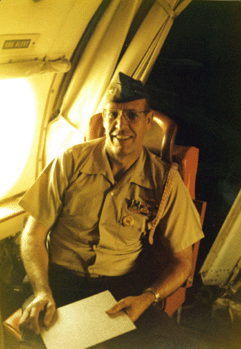
Marine Corps Aide to the Secretary of the Navy - The Pentagon, Washington, D.C., 1976-1979
I interviewed with the Secretary of the Navy, who at that time [1976] was J. William Middendorf II.gif. It was [part of] my job to plan his trips.... [At the U.S. Bicentennial] on July 4, 1976, in New York Harbor, on the carrier Forestal, there were about 4,000 dignitaries onboard to watch the Parade of Sail and the International Naval Review. And of course the Secretary of the Navy -- he's the host for that thing. President Ford came out to the ship that day.... I was standing probably 10, 15 feet from the President....
We were in Europe the night of the election, when President Ford lost to Carter. And of course Mr. Middendorf was very disappointed about that being a staunch Republican and everything.... I was expecting to lose that job when the Carter administration took power and came in, because I figured whoever the new Secretary was going to be, he would replace all of the old regime. It turned out to be a guy by the name of Graham Claytor, W. Graham Claytor, Jr.... Mr. Claytor kept me. He told me later on, he says, I know I can trust a Marine. From taped interview, November 11, 2003
Legislative Assistant to the Commandant (Washington, D.C., 1981-1983)
Some of the things that we were trying to get through the Congress were the AV-8B, the Harrier jump jet, the F-18. We were trying to get a bigger ship called the LSD-41 for carrying troops, and we were trying to get the LAV, the Light Armored Vehicle, so we had to fight for those things in the Navy budget as it was going through the Hill. I found that the Marine Corps has a great number of friends on Capitol Hill. At that time I think they had 35 or 40 members of Congress who had served in the Marine Corps. Now it's diminished, in fact there are very few members of Congress that have served in any of the services. But some of the people, the Marines that I knew - one from Kansas, Senator Pat Roberts. He was a member of the House at that time.... One of the things I did as the legislative assistant to the Commandant was to hold a quarterly breakfast on the Hill for all of the former Marines that were serving in Congress. And we usually had about 30 of them show up.
From taped interview, November 11, 2003

Commander of Marine Corps Air Bases, Western Area - Commanding General, Marine Corps Air Station (El Toro, California, 1984-1986)
In August of 1983 I got assigned to be the assistant wing commander at El Toro, California. So, we went all the way back cross country to El Toro, and lived on the base, the little helicopter base at Tustin, and I drove six miles over to El Toro everyday. I worked for a two-star by the name of Clay Comfort, who also was from Kansas, by the way, went to the University of Kansas, in fact he lives in Lawrence today. I had that job a year and was then made the commander of Marine Corps Air Bases West. I had four major bases under me – Marine Corps Air Station Yuma, the Marine Corps Air Station Tustin, which was a helicopter base, the Marine Corps Air Station at Camp Pendleton, and El Toro.... We received two awards from President Reagan for base excellence at El Toro as part of the model installations program that was sponsored by the Department of Defense. We were named the best base in the Marine Corps for two consecutive years.
From taped interview, November 11, 2003
Service Resume
William Arthur Bloomer was born January 23, 1933, in Bellaire, Kansas. He attended high school in Lebanon, Kansas, and earned a B.S. degree in Education, with teaching fields in Mathematics and Physics, from Kansas State Teachers College, Emporia, where he was a four-year letterman in football and basketball. After graduation from KSTC in 1955, he was commissioned a second lieutenant in the U.S. Marine Corps Reserve. Two years later, he received his regular commission.
Completing naval flight training in 1958, he remained in advanced jet training at Kingsville, Texas, as a flight instructor. He was promoted to captain in December 1959.
He attended Naval Test Pilot School in 1965 and served as a project test pilot at the Naval Air Test Center, Naval Air Station, Patuxent River, Maryland, during 1966-68. While serving in this assignment, he was promoted to major in June 1966. General Bloomer is an Associate Member of the Society of Experimental Test Pilots.
During 1968-69, he saw combat service in Vietnam, flying 330 combat missions in the RF-4B and EA-6A aircraft. Upon returning from Vietnam, he attended graduate school at Rensselaer Polytechnic Institute in Troy, N.Y., and received his M.S. degree in Management in 1970.
He served as the Commanding Officer, Headquarters and Headquarters Squadron at Marine Corps Air Station, Kaneohe Bay, Hawaii, during 1971-73, and also was a member of the adjunct faculty of the University of Southern California. Upon graduation with distinction from the Naval War College, Newport, R.I., in 1974, he served as Commanding Officer of Marine Composite Reconnaissance Squadron-1 aboard the USS Midway. While in Hawaii, he was promoted to lieutenant colonel in October 1971.
From June 1976 until July 1979, he served as Special Assistant and Marine Corps aide to two secretaries of the Navy, The Honorable J. William Middendorf II and The Honorable W. Graham Claytor Jr. He was promoted to colonel in June 1976.
General Bloomer served nine months as the Assistant Chief of Staff, G-3 for the 2d Marine Aircraft Wing, prior to being assigned the Chief of Staff of the 2d Marine Aircraft Wing in June 1980. While serving in this capacity, he was selected in February 1981 for promotion to brigadier general. He was advanced to that grade on April 24, 1981, and assigned duty as the Legislative Assistant to the Commandant of the Marine Corps on May 23, 1981. He assumed duty as the Assistant Wing Commander, 3d Marine Aircraft Wing on August 8, 1983. He was assigned additional duties as the Commanding General, 5 th Marine Amphibious Brigade on February 23, 1984.
In July 1984, General Bloomer became Commander of Marine Corps Air Bases, Western Area, and Commanding General, Marine Corps Air Station, El Toro, California. He retired from the Corps in June 1986.
General Bloomer's personal decorations include: The Legion of Merit; Distinguished Flying Cross; Bronze Star Medal with Combat "V"; 17 Air Medals; and the Republic of China Kuang Hua Medal.
General Bloomer was named an ESU Distinguished Alumni in 1985. He has recently been appointed to the ESU Foundation Board of Directors. He is also first vice president of the national board of trustees of Phi Kappa Sigma.
General Bloomer and his wife, the former Sharon Sue Vernon of Emporia, Kansas, have three children, Leigh Anne, Jeffrey, and Brenda. They have recently returned to Kansas and reside in Wichita.
Post-Marines Career (A Sampling) 1986 - Present
- Executive Vice President, American Protective Services - 1986-2000
- City Councilman, Irvine City Council, Irvine, California - 1990-1993
- Military Affairs Analyst, KCAL, Channel 9, Los Angeles, California - 1991, 2001 - Present
- Executive Director, Orange County Regional Airport Authority, Orange County, California - 2001-2002
- Trustee and First Vice President, Phi Sigma Kappa Foundation - 2002 - Present
- CEO and Chairman of the Board, Integrated Data Corporation - 2002 - Present
- Trustee, Emporia State University Foundation - 2003 - Present
